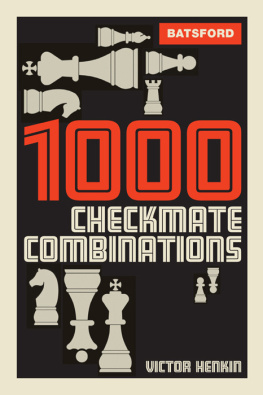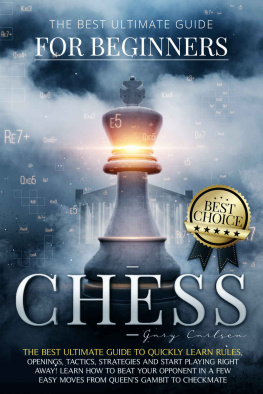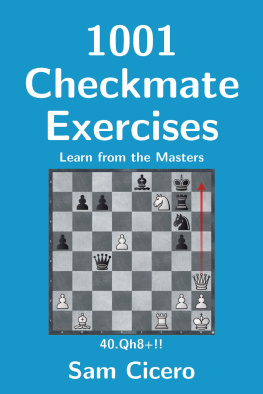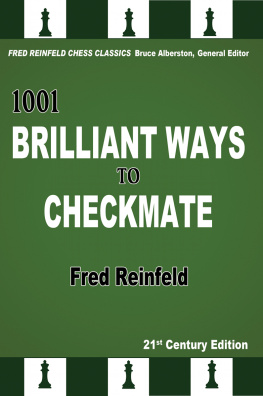Victor Henkin - 1000 Checkmate Combinations
Here you can read online Victor Henkin - 1000 Checkmate Combinations full text of the book (entire story) in english for free. Download pdf and epub, get meaning, cover and reviews about this ebook. year: 2011, genre: Science / Home and family. Description of the work, (preface) as well as reviews are available. Best literature library LitArk.com created for fans of good reading and offers a wide selection of genres:
Romance novel
Science fiction
Adventure
Detective
Science
History
Home and family
Prose
Art
Politics
Computer
Non-fiction
Religion
Business
Children
Humor
Choose a favorite category and find really read worthwhile books. Enjoy immersion in the world of imagination, feel the emotions of the characters or learn something new for yourself, make an fascinating discovery.
- Book:1000 Checkmate Combinations
- Author:
- Genre:
- Year:2011
- Rating:3 / 5
- Favourites:Add to favourites
- Your mark:
- 60
- 1
- 2
- 3
- 4
- 5
1000 Checkmate Combinations: summary, description and annotation
We offer to read an annotation, description, summary or preface (depends on what the author of the book "1000 Checkmate Combinations" wrote himself). If you haven't found the necessary information about the book — write in the comments, we will try to find it.
1000 Checkmate Combinations — read online for free the complete book (whole text) full work
Below is the text of the book, divided by pages. System saving the place of the last page read, allows you to conveniently read the book "1000 Checkmate Combinations" online for free, without having to search again every time where you left off. Put a bookmark, and you can go to the page where you finished reading at any time.
Font size:
Interval:
Bookmark:
First published in the United Kingdom in 2011 by Batsford
Old West London Magistrates Court
10 Southcombe Street
London
W14 0RA An imprint of Anova Books Company Ltd Originally published in Russian by Russian Chess House Limited Copyright 2011 Text copyright Victor Henkin 2011 The moral right of the author has been asserted. All rights reserved. No part of this publication may be reproduced, stored in a retrieval system, or transmitted in any form or by any means electronic, mechanical, photocopying, recording or otherwise, without the prior written permission of the copyright owner. First eBook publication 2012
eBook ISBN: 9781849940955 Also available in paperback
Paperback ISBN: 9781906388706 This book can be ordered direct from the publisher at www.anovabooks.com
How did he find that combination? How did he discern it among the dozens of other moves and possibilities? When Im studying a specific position, above all I note its peculiarities, the reciprocal positioning of the pieces, their connections. And suddenly (in the majority of cases this occurs intuitively) somewhere nearby the indistinct features of some new teasing and appealing position become faintly perceptible. It isnt on the board yet, of course, but everything points to the fact that it may arise. The hunt for the blue bird begins. Often the calculating of variations turns out to be a Sysyphean task. The position in your minds eye hardly ever comes about, even if your opponent joins you in a cooperation.
Some piece is on the wrong square, some pawn is getting in the way But it can happen that the tedious calculation of variations brings real results. Move for move you get exactly the same position that you saw from afar. And if the circle of variations has been exhausted, then Then you can start the combination. A successful combination provokes admiration not only in the spectators; it also becomes a starring moment for the chess player himself. But although each of us thinks that weve created something original, in fact, even if its subconsciously, weve only reproduced something that weve already seen or encountered somewhere and sometime. Most chess combinations have already squeezed into the Procrustean bed of standard plans.
From the methodological standpoint this is essential, but from the point of view of an artist its sad. I myself hate to admit that Im an imitator of chess science. And its no coincidence that Emanuel Lasker said that before participating in tournaments he wished he could forget everything he knew, just to play freely and uninhibitedly without burdening himself with knowledge, so that during a game he wouldnt have to remember what theory recommended and on which page. Thats only a dream, alas. The joy of great discoveries has been left in the distant past. Information has swamped the entire world, including the chess world.
The century has dawned, I would say, of pathologically increasing knowledge. Chess has now achieved such a level that inventing something fundamentally new is unbelievably difficult. Everythings been done, almost everything But still it came as an enormous surprise to me that a three-digit number of typical mating finales exist, which are already included on the black list of chess theory, and the chess players task has been reduced to forcing a nontypical position to become a typical one. Theres no doubt that very complicated combinations are encountered in chess that can be found only by a player who is endowed with sharp tactical vision and who possesses an excellent ability to calculate. But no matter how complicated and original the combination itself is, as a rule it leads to a position that yields to a specific evaluation. And the most important thing is to see this in time and correctly evaluate the final position.
Of course, chess creativity hasnt been restricted once and for all by established boundaries. Every player improvises to the extent of his talent and imagination. But in places where you just have to know things you shouldnt reinvent the bicycle. This book isnt just an anthology of mating combinations. The last check isnt necessarily the final chord of a game. Its the note that nearly always sounds the leitmotif for many combinations associated with winning material or achieving other advantages.
Mating finales are encountered rather infrequently in high-level tournament practice, but they are always present out of frame, just as the multiplication table stands invisibly behind the most complex mathematical formulae. In this book youll find numerous examples where merely the threat of mate turned out to be the decisive factor in the battle. There hasnt been a book like this before in our chess literature. The author has done an enormous amount of work selecting and systematising the material. An experienced master, who in the recent past himself participated in competitions and had a reputation as a staunch tactician, he has retained a particular taste for the last check. This book is easy to read.
It has been written clearly, in vivid language, with the soft shading of the authors inherent humour. This book will be particularly useful for chess players who are starting their creative life. It serves as a solid guide to the world of chess combinations, explains the significance of many of the road signs and shortens the road to mastery. In Masters of the Chessboard Richard Reti writes: There is a widespread but mistaken notion that the art of combination in chess cannot be learnt and that it is all down to an inborn power of calculation and imagination. But any experienced player knows that most combinations, indeed, practically all of them, are devised by recalling known elements, as, for example, the famous bishop sacrifice on Whites h7, which will not give the advanced player anything much to think about. It would be a grateful task to write a complete theory of combinations, which would have to demonstrate the ever recurring types, and show what principal factors must be kept in mind in judging the correctness of combinations and in carrying them out.
Precisely that work is in front of you. Mikhail Tal
Former World Chess Champion
Up until the end of the 19th century an irrefutable check was announced with the words check and mate. This served as a kind of proof that checkmate hadnt been given accidentally (a blind mate, as they used to say in Russia. This term can be found in the late 19th-century Brockhaus and Efron Encyclopedic Dictionary), but as a result of precise calculation. Here White (Black) announced mate in such-and-such a number of moves may be encountered in many notes to games not only by Steinitz and Chigorin, but also by later commentators. Mating positions have long been considered the crown of chess creativity. In the distant past the rules of the game were distinguished from the modern ones by the slower movement of certain pieces (in particular, the queen and bishop), so mating finales were encountered extraordinarily rarely and were highly valued by our predecessors.
Especially beautiful and unexpected endings received their own names. In later times, when reform of the game of chess, as Dutch historian Antonius van der Linde put it, abolished the eastern slowness and started hurried chess, mating positions ceased to be museum pieces. But even today checkmate cant be seen on the board that often: chess players try to put an end to their torments and resign, as a rule, before the final gong. Still, the goal of the game of chess remains unchanged to give mate to the enemy king. All of the chess players thoughts are subordinated, in essence, to this goal. As a rule a single piece strikes the final blow against the enemy king.
Font size:
Interval:
Bookmark:
Similar books «1000 Checkmate Combinations»
Look at similar books to 1000 Checkmate Combinations. We have selected literature similar in name and meaning in the hope of providing readers with more options to find new, interesting, not yet read works.
Discussion, reviews of the book 1000 Checkmate Combinations and just readers' own opinions. Leave your comments, write what you think about the work, its meaning or the main characters. Specify what exactly you liked and what you didn't like, and why you think so.









